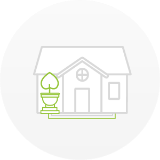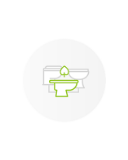EcoLet™ Troubleshooting Guide
Where to start...
There are 4 key considerations when addressing faults with the composting system that need to be inspected. Most composting systems have the following design aspects that are key.
Ventilation systems are used to provide the following
- Odour free operation
- Oxygen supply to the composting process
- Drying or evaporating liquids, keeping in mind that for composting to take place the compost itself must have no less than 45% moisture
- Prevent insects from entering the composting system by providing directional air flow
- Is a code requirement
Moisture management systems (leachate drain)
- Leachate in most system is the residual moisture left over from the biological composting process that needs to be discharged
- Leachate drains are generally required to prevent the build-up of moisture in the base of the composting chambers
- Manage moisture when systems are subject to overuse
- Is a code requirement
Organic carbon materials
- Compost would not be compost without the compositions of nitrogen and carbon
- Carbon materials feed the composting process
- Provide a bulking bed for waste (human dejecta) to break down in
- Is a wicking bed for moisture to spread evenly
- Will allow the dejecta to fully break down resulting in rich organic soil in a timely fashion
Human dejecta (waste-not)
- Human dejecta being poos (faecal matter) and wees (urine) is necessary to feed the composting process
- Poos provide to the composting process the base stock for biological life, not only giving nitrogens but introducing bacteria to the process
- Wees provides more nitrogens and maintain the moisture in proportion to the amounts of poos and carbon materials added, preventing the composting from becoming too dry
There are a few more considerations to the effectiveness of composting and these are whether or not you have a heated system and the climatic conditions the system is used in. These are addressed in the manuals and troubleshooting below.
Brief Troubleshooting FAQ’s covered here.
See system manuals for comprehensive Troubleshooting guides (Link)
Why is the compost chamber filling up too quickly?
This can be caused by ineffective composting process due to a number of issues listed below:
Compost pile being too wet
This means the liquid is trapped in the compost chamber contributing to quick volume build up.
Check if the drainage outlet is being blocked - this could be caused by solids blocking the drainage system. See respective manuals for how to clean drain systems.
If drainage outlet is ok, consider the following.
Insufficient air flow
Without sufficient air flow, the evaporation process will be slowed and odours start to escape into the toilet room. A malfunctioning fan or ventilation system can cause this.
Has the ventilation system been blocked by dust, insects, bulking materials or toilet paper?
The fan might not be running, check the electrical connections.
Climate – Temperature & atmosphere conditions
WCTNZ® make every attempt to match you with the right system meeting your site and climate conditions, but there can be changes in weather patterns that lead to less than ideal situations.
In the colder climate, systems can slow down in their rate of processing. Depending on the type of system you have this may not be a problem.
In wetter or salt-laden air climates the system may retain too much moisture as the salt works as a wetting agent by holding on to moisture like water crystals.
Overuse
Although most composting systems have an allowed over-use capacity for guest, there can be unexpected additional users that push the system beyond its limits.
Why is the composting process slow to complete?
Composting process is dependent on temperature and humidity. Listed below are factors that could slow down the process:
Compost pile being too wet
The addition of wood shavings is an imperative part of the operation of a composting toilet. Wood shavings will assist with the absorption of liquid in your composting toilet and will aid in improving the carbon/nitrogen ratio (important for composting) and will allow air to move more freely through the system as it loosens the compost pile.
Compost pile surrounding temperature is too low
You can..
Turn up the heating if your system is a heated model.
Turn down the fan voltage to lessen cool air being drawn into the system. If odour occurs due to the fan voltage being turned down low, simply turn it up slightly to increase airflow.
Add insulation to the tank but not if it’s in a sunny location where the heat is warming the tank.
For the two-stage system where secondary treatment is required, when taking the compost chamber out for secondary composting, make sure it is located in a warm spot preferably in direct sunlight.
How to deal with insects attracted to the compost pile?
Usually, insects in the compost pile indicate that the Humus is too dry. Add a cup of water to the compost.
Insect Control
To break the breeding cycle of insects (most commonly vinegar flies) spray the compost pile with pyrethrum-based insect spray for 7 consecutive days. Always place a layer of wood shavings over the top of the pile in the out of service chamber to eliminate the possibility of insects laying eggs.
EcoLet™ - Troubleshooting
The following Guide is available in full form in the official EcoLet™ Owner’s Manual. (These instructions mainly refers to the EcoLet™ 240 range)
For your convenience, it is available here in detail if your manual is no longer available. To download your system manual please log in to see your system and corresponding documents.
Odour present in the toilet room
A properly functioning EcoLet™ system does not produce odours in the toilet room. Occasionally, however, the draft of the system may become impaired or a leak may develop in the vent resulting in odour.
Note: You should never use a room exhaust fan where an EcoLet™ is installed as the exhaust fan will draw back any odour from the toilet system (particularly if the toilet seat is not closed). The fan in the toilet vent pipe will be sufficient to draw any lingering odour out of the toilet room.
Recommended Course of action.
Check that the unit is still plugged in, that there is power to the plug, and you can hear the fan motor running.
Check your EcoLet™ is vented correctly and that the vent pipe connections are airtight.
Check that the vent pipe is unobstructed by bulking materials or toilet paper. Clean if necessary.
Check that the front cover for the humus tray is properly secured.
Check that open windows and doors are not ‘sucking’ air out of the toilet room due to outside air. Turbulence. This can overcome the suction of the vent fan.
Is excess moisture present in the indicator tubes on the side of the system? Fix; Increase thermostat setting, check the installation, too many people are using the toilet.
An odour is present outside the building but not inside.
Recommended Course of action.
Check that the vent pipe extends at least 600mm higher than the apex of your roof.
The exhaust should be low in odour. Smell can be caused by underperforming of composting. Please see above for factors that may be causing this.
Odour is associated with the end-product.
If the finished product from the removable tray is not light, friable and clean smelling, this could mean you are not achieving complete compost.
Recommended Course of action.
Please see above for factors that may be causing compost to underperform.
Fan is making a lot of noise
Recommended Course of action.
Check that the fan is not obstructed with bulking materials or toilet paper. If it is not, the fan could be broken.
Check fan blades and bearings.
Liquid in indicator tubes or excess moisture in upper composting chamber
Recommended Course of action.
If you see liquid in the indicating tube(s), control it by adjusting the thermostat. If the liquid is in the Indicating Tube on the left side of the toilet (when facing toilet), DO NOT OPEN the front cover.
This tube indicates liquid outside the tray. Removal of the front cover will release liquid onto the floor. If the material inside the upper composting chamber is not loamy and appears to be holding excessive moisture, adjust the thermostat and/or add bulking agent.
- Is your unit plugged in and is there power to the plug? Can you hear the fan motor running?
- Check and see if your thermostat is working by turning it from “1” to “10” and listen for a quiet “click”
- Check and see if your heater is working by turning the thermostat up to “10” for 30 minutes and use your hand to feel the middle back of the toilet, just below the seam where the top joins the bottom. You should feel a small amount of heat in this area.
- In the upper composting chamber ensure the mulch is not compacted (use manual rake).
- Ensure you are using the toilet within its capacity.
- Make sure you are using only our special WCTNZ® Eco Mix and you are adding enough.
- Ensure there is sufficient ventilation to the toilet (see “Odour present in the toilet room above”)
Compost tank is getting too full
Recommended Course of action.
Check that there are not too many people using the toilet
In the case of EcoLet™ NE systems simply empty the system into a secondary compost system, make sure it is located in a warm spot preferably in direct sunlight.
For EcoLet™ 240 range empty the removable tray and replace, then manually turn (manual model) or with the micro-switch press to deposit compost into the bottom tray allowing new space on the top of the compost pile to carry on using the system.
The composting process does not seem to be working
Composting pile appears too dry.
Recommended Course of action.
The compost is too dry when it becomes hard, the paper stays on top and is not mixed into the compost. There should always be at least 10 cm (4”) of compost on the grate in the bottom of the composting chamber (about 1/3 full). Turn the thermostat setting down to a lower number to avoid dryness. If the compost remains very dry, sprinkle some water over the compost, not faster than the compost can absorb, at the same time as you run the mixer. Continue with this as long as the compost absorbs the water. You might have to use the hand rake to break up the hard areas. If there is a build-up of dry paper, sprinkle approx. 1 litre of water over it to make it shrink.
Compost pile appears too wet.
Recommended Course of action.
Check that the fan is running (you can hear it) and that the heating element is working (you can feel the warmth with your hand on the back of the toilet's lower section)
To increase the evaporation of liquid:
- Mix some extra WCTNZ® Eco Mix into the compost
- Set the thermostat to a higher setting and do not turn it down until the liquid in the tube has almost disappeared. It can take a week or two until it disappears depending on use.
- Check that the toilet has not been overloaded with too many users
- Check that you are not in a heavy sea zone as salt makes air wetter.
There seems to be too much toilet paper visible on the top of the pile.
Ensure sufficient bulking agents are being added regularly (per use).
Consider that some people use much more toilet paper than is necessary.
Recommended Course of action.
Simply dampen down if necessary and agitate top 100mm or so of the compost pile to mix with the wood shavings.
Check that the composting system is not too hot and dry as moisture will break apart the toilet paper.
Consider the type of toilet paper used. Recycled toilet paper breaks down the fastest and hypoallergenic toilet paper has fewer chemicals that could resist the composting process but in general, this is not a problem.
Composting pile may be too cold for composting.
Climate – Temperature & atmosphere conditions.
WCTNZ® make every attempt to match you with the right system meeting your site and climate condition but there can be changes in weather patterns that lead to less than ideal situations.
In the colder climate, systems can slow down in the rate of processing.
Check that the surrounding temperature is not too low.
For the two-stage system where secondary treatment is required make sure when taking the compost chamber out for secondary composting, that it is located in a warm spot - preferably in direct sunlight.
Undesirable insects in the compost tank.
If insects have gotten into the compost one should sprinkle either Insect stopper or any other long-lasting powder (pyrethrum based) over the compost and also in the compost removal tray.
Refer to the section on Compost Toilets and Insects in the Manual.















